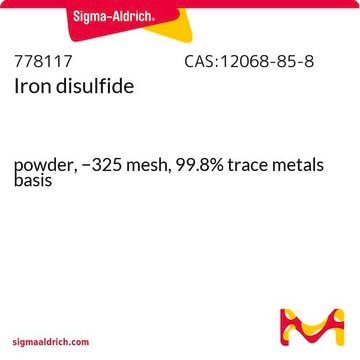343161
Iron(II) sulfide
−100 mesh, 99.9% trace metals basis
Synonyme(s) :
Ferrous sulfide
Se connecterpour consulter vos tarifs contractuels et ceux de votre entreprise/organisme
About This Item
Formule empirique (notation de Hill):
FeS
Numéro CAS:
Poids moléculaire :
87.91
Numéro CE :
Numéro MDL:
Code UNSPSC :
12352302
eCl@ss :
38190405
ID de substance PubChem :
Nomenclature NACRES :
NA.55
Essai:
99.9% trace metals basis
Forme:
powder
Produits recommandés
Niveau de qualité
Essai
99.9% trace metals basis
Forme
powder
Pertinence de la réaction
reagent type: catalyst
core: iron
Taille des particules
−100 mesh
Densité
4.84 g/mL at 25 °C (lit.)
Chaîne SMILES
S=[Fe]
InChI
1S/Fe.S
Clé InChI
MBMLMWLHJBBADN-UHFFFAOYSA-N
Vous recherchez des produits similaires ? Visite Guide de comparaison des produits
Application
- Progress in bioleaching: fundamentals and mechanisms of microbial metal sulfide oxidation - part A: This study delves into the microbial oxidation of metal sulfides like Iron(II) sulfide, shedding light on bioleaching processes crucial for the extraction of valuable metals from ores, which is highly relevant for environmental and materials science applications (Vera et al., 2022).
- Novel QTL Associated with Aerenchyma-Mediated Radial Oxygen Loss (ROL) in Rice: Explores genetic traits influenced by conditions such as the presence of Iron(II) sulfide in paddy fields, providing insights into how rice adapts to iron-rich anaerobic soils, which is vital for agricultural biotechnology and crop science (Duyen et al., 2022).
- Fe(ii) and Fe(iii) dithiocarbamate complexes as single source precursors: Investigates the synthesis of nanoscale iron sulfides from these precursors, using in situ X-ray absorption spectroscopy, which is essential for developing advanced materials with specific magnetic and electronic properties (Roffey et al., 2019).
Code de la classe de stockage
11 - Combustible Solids
Classe de danger pour l'eau (WGK)
WGK 3
Point d'éclair (°F)
Not applicable
Point d'éclair (°C)
Not applicable
Faites votre choix parmi les versions les plus récentes :
Déjà en possession de ce produit ?
Retrouvez la documentation relative aux produits que vous avez récemment achetés dans la Bibliothèque de documents.
Les clients ont également consulté
N Finck et al.
Environmental science & technology, 46(18), 10004-10011 (2012-08-21)
The isotope (79)Se may be of great concern with regard to the safe disposal of nuclear wastes in deep geological repositories due to its long half-life and potential mobility in the geosphere. The Se mobility is controlled by the oxidation
Amit Kumar Dutta et al.
ACS applied materials & interfaces, 4(4), 1919-1927 (2012-03-28)
Nanocrystalline FeS and FeSe compounds were prepared by solvothermal decomposition of a precursor complex [Fe(3)(μ(3)-O)(μ(2)-O(2)CCH(2)Cl)(6)(H(2)O)(3)]NO(3)·H(2)O in the presence of thiourea and sodium selenite, respectively. The as-obtained products were characterized by X-ray diffraction analysis (XRD), field emission scanning electron microscopy (FESEM)
Andrew D Henderson et al.
Water research, 47(3), 1267-1276 (2012-12-19)
Iron sulfide (FeS) has been extensively assessed as a reactive medium to remove both metals and halogenated organics from groundwater. However, to address its suitability as a material for permeable reactive barriers (PRBs), its propensity for solids and gas production
The structural plasticity of the proximal [4Fe3S] cluster is responsible for the O2 tolerance of membrane-bound [NiFe] hydrogenases.
Jean-Marie Mouesca et al.
Angewandte Chemie (International ed. in English), 52(7), 2002-2006 (2013-01-09)
Bin Huang et al.
Bioresource technology, 102(21), 10154-10157 (2011-09-07)
The performance of acetic acid-supported pH-heterogenized heterotrophic denitrification (HD) facilitated with ferrous sulfide-based autotrophic denitrification (AD) was investigated in upflow activated carbon-packed column reactors for reliable removal of highly elevated nitrate (42 mg NO(3)-Nl(-1)) in drinking water. The use of
Notre équipe de scientifiques dispose d'une expérience dans tous les secteurs de la recherche, notamment en sciences de la vie, science des matériaux, synthèse chimique, chromatographie, analyse et dans de nombreux autres domaines..
Contacter notre Service technique











